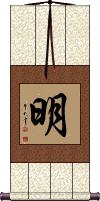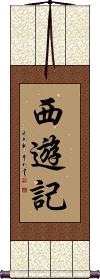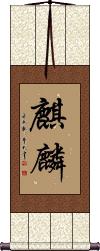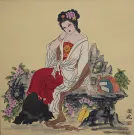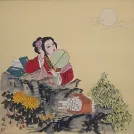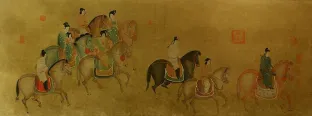Many custom options...
And formats...

Ming Dynasty in Chinese / Japanese...
Buy a Ming Dynasty calligraphy wall scroll here!
Personalize your custom “Ming Dynasty” project by clicking the button next to your favorite “Ming Dynasty” title below...
Light / Bright
明 means light, bright, clear, clarity, to understand, or wise.
In Chinese, this can refer to the Ming Dynasty (1368-1644) where it can also be the surname Ming.
In Japanese, this can be romanized many different ways when used as surnames or given names. 明 is a partial list of those names: Meishuu, Mei, Min, Myoujin, Myou, Hinata, Haru, Toshi, Tooru, Sayaka, Saya, Satoshi, Asumi, Akera, Akemine, Akesaki, Ake, Akuru, Akiraka, and Akira.
In the Buddhist context, this represents vidyā (knowledge). To expand that, Buddhists understand this to mean bright, clear, enlightenment, wisdom, or to understand. It represents Buddha-wisdom and its revelation; also the manifestation of a Buddha's light or effulgence.
Journey to the West
西遊記 is the original title of the novel Journey to the West.
Written during the Ming dynasty, this novel by Wu Cheng'en (吳承恩) is one of the four classic stories of Chinese literature.
Sometimes this book is titled, Pilgrimage to the West, Monkey King, or Magic Monkey.
Many movies and TV series depict or adapt portions of this story.
Kirin / Giraffe / Mythical Creature
麒麟 is the title of a mythical beast of Asia.
The animal is thought to be related to the giraffe, and in some ways, it is a giraffe. However, it is often depicted with the horns of a dragon or deer and sometimes with the body like a horse, but many variations exist.
In Japanese, it is pronounced “Kirin” as in “Kirin Ichiban” beer.

Notes:
1. This is sometimes spelled as “kylin.”
2. In Japanese, this is the only Kanji word for giraffe. Therefore in Japan, this word needs context to know whether you are talking about the mythical creature or the long-necked giraffe of Africa.
3. Apparently, this was the first word used for regular giraffes in China (some were brought from Africa to China during the Ming Dynasty - probably around the year 1400). Though the mythical creature may have existed before, the name “qilin” was given to the “new giraffe.” This is because, more than 600 years ago, giraffes somewhat matched the mythical creature's description when Chinese people saw them for the first time. Later, to avoid such an ambiguous title, a three-character word was devised to mean a “giraffe of Africa.” The characters for “qilin” shown here are only for the mythological version in modern Chinese.
4. More information about the qilin / kirin from Wikipedia.
5. This creature is sometimes translated as the “Chinese Unicorn,” although it is generally portrayed with two horns. I think this is done more for the fantasy aspect of the unicorn and because most westerners don't know what a qilin or kirin is (this avoids a long explanation by the translator).
6. In Korean, this can mean kirin or simply giraffe (usually, the mythological creature is what they would think of when seeing these characters alone on a wall scroll).
This in-stock artwork might be what you are looking for, and ships right away...
Gallery Price: $180.00
Your Price: $99.88
Gallery Price: $107.00
Your Price: $59.00
Gallery Price: $150.00
Your Price: $79.88
Gallery Price: $180.00
Your Price: $99.88
Not the results for ming dynasty that you were looking for?
Below are some entries from our dictionary that may match your ming dynasty search...
| Characters If shown, 2nd row is Simp. Chinese |
Pronunciation Romanization |
Simple Dictionary Definition |
明 see styles |
míng ming2 ming mei / me めい |
More info & calligraphy: Light / Bright(1) (ant: 暗) brightness; (2) discernment; insight; an eye (for); (3) (See 明を失う) eyesight; vision; (prefix) (4) (abbreviation) (See 明治) nth year in the Meiji era (1868.9.8-1912.7.30); (surname) Meishuu vidyā, knowledge. ming means bright, clear, enlightenment, intp. by 智慧 or 聰明 wisdom, wise; to understand. It represents Buddha-wisdom and its revelation; also the manifestation of a Buddha's light or effulgence; it is a term for 眞言 because the 'true word' can destroy the obscurity of illusion; the 'manifestation' of the power of the object of worship; it means also dhāraṇīs or mantras of mystic wisdom. Also, the Ming dynasty A. D. 1368-1644. |
南京 see styles |
nán jīng nan2 jing1 nan ching nankin ナンキン |
More info & calligraphy: Nanjing(1) Nanjing (China); Nanking; (2) (ksb:) (See カボチャ) pumpkin; squash; (prefix noun) (3) Chinese; Southeast Asian; foreign; (prefix noun) (4) rare; precious; cute; (place-name) Nanking (China); Nanjing |
西遊記 西游记 see styles |
xī yóu jì xi1 you2 ji4 hsi yu chi saiyuuki; seiyuuki / saiyuki; seyuki さいゆうき; せいゆうき |
More info & calligraphy: Journey to the West(1) (work) Journey to the West (classic of Chinese literature); (2) (work) Alakazam the Great (1960 animated film); (3) (work) Monkey (1978-1980 TV series); Monkey Magic; (4) (work) Saiyūki (2006 TV series); (wk) Journey to the West (classic of Chinese literature); (wk) Alakazam the Great (1960 animated film); (wk) Monkey (1978-1980 TV series); Monkey Magic; (wk) Saiyūki (2006 TV series) |
五山 see styles |
wǔ shān wu3 shan1 wu shan gosan; gozan ごさん; ござん |
(rare) five most important temples of a region; (surname) Goyama Five mountains and monasteries: (1) in India, sacred because of their connection with the Buddha: 鞞婆羅跋怒 Vaibhāra-vana; 薩多般那求呵 Saptaparṇaguhā; 因陀羅勢羅求呵 Indraśailaguhā; 薩簸恕魂直迦鉢婆羅 Sarpiṣ kuṇḍikā-prāgbhāra; 耆闍崛 Gṛdhrakūṭa; (2) in China, established during the Five Dynasties and the Southern Sung dynasty, on the analogy of those in India; three at Hangzhou at 徑山 Jingshan, 北山 Beishan, and 南山 Nanshan and two at Ningbo at 阿育王山 King Aśoka Shan and 太白山 Taiboshan. Later the Yuan dynasty established one at 全陵 Chin Ling, the 天界大龍翔隻慶寺 which became chief of these under the Ming dynasty. |
元史 see styles |
yuán shǐ yuan2 shi3 yüan shih motofumi もとふみ |
History of the Yuan Dynasty, twenty third of the 24 dynastic histories 二十四史[Er4 shi2 si4 Shi3], compiled under Song Lian 宋濂[Song4 Lian2] in 1370 during the Ming Dynasty, 210 scrolls (personal name) Motofumi |
南藏 see styles |
nán zàng nan2 zang4 nan tsang Nanzō |
The Southern Collection, or Edition, of the Chinese Buddhist Canon, published at Nanking under the reign of Tai Tsu, the first emperor of the Ming dynasty, who reigned A.D. 1368-1398. |
增生 see styles |
zēng shēng zeng1 sheng1 tseng sheng |
(medicine) hyperplasia; (abbr. for 增廣生員|增广生员[zeng1guang3 sheng1yuan2]) a scholar studying for the Ming dynasty imperial examinations who did not make the quota for support in the form of a monthly allowance of rice that students who made the quota received |
宋濂 see styles |
sòng lián song4 lian2 sung lien |
Song Lian (1310-1381), Ming dynasty writer, historian and politician |
寶船 宝船 see styles |
bǎo chuán bao3 chuan2 pao ch`uan pao chuan |
Chinese treasure ship, a type of large sailing ship in the fleet of Ming dynasty admiral Zheng He 鄭和|郑和[Zheng4 He2] See: 宝船 |
張溥 张溥 see styles |
zhāng pǔ zhang1 pu3 chang p`u chang pu |
Ming dynasty scholar (1602–1641), prolific writer, proponent of the Fushe 復社|复社[Fu4she4] cultural renewal movement, author of Five Men's Tombstone Inscription 五人墓碑記|五人墓碑记[Wu3 Ren2 Mu4bei1ji4] |
徐渭 see styles |
xú wèi xu2 wei4 hsü wei joi じょい |
Xu Wei (1521-1593), Ming dynasty Chinese painter and author (personal name) Joi |
應文 应文 see styles |
yìng wén ying4 wen2 ying wen Ōmon |
Yingwen; the grandson of the founder of the Ming dynasty, Taizu, to whom he succeeded, but was dethroned by Yung Lo and escaped disguised as a monk; he remained hidden as a monk till his 64th year, afterwards he was provided for by the reigning ruler. His name is also given as 應能 Yingneng; 應賢 Yingxian; and posthumously as 允炆 Yunwen. |
把總 把总 see styles |
bǎ zǒng ba3 zong3 pa tsung |
low-level officer of the army from the Ming to the mid Qing Dynasty |
明代 see styles |
míng dài ming2 dai4 ming tai mindai みんだい |
the Ming dynasty (1368-1644) (hist) (See 明) Ming period (China; 1368-1644); Ming era; (given name) Haruyo |
明史 see styles |
míng shǐ ming2 shi3 ming shih meiji / meji めいじ |
History of the Ming Dynasty, twenty fourth of the 24 dynastic histories 二十四史[Er4 shi2 si4 Shi3], compiled under Zhang Tingyu 張廷玉|张廷玉[Zhang1 Ting2 yu4] in 1739 during the Qing Dynasty, 332 scrolls (personal name) Meiji |
明朝 see styles |
míng zhāo ming2 zhao1 ming chao minchou / mincho みんちょう |
tomorrow morning; the following morning (1) (hist) Ming dynasty (of China; 1368-1644); (2) (abbreviation) (See 明朝体) Ming (typeface); Minchō |
明藏 see styles |
míng zàng ming2 zang4 ming tsang Myō zō |
The Buddhist canon of the Ming dynasty; there were two editions, one the Southern at Nanjing made by T'ai Tsu, the northern at Beijing by Tai Tsung. A later edition was produced in the reign of Shen Tsung (Wan Li), which became the standard in Japan. |
湖廣 湖广 see styles |
hú guǎng hu2 guang3 hu kuang |
Hubei and Hunan provinces (a Ming dynasty province) |
瓦剌 see styles |
wǎ là wa3 la4 wa la |
Oirat Mongols (alliance of tribes of Western Mongolia) (Ming Dynasty term) |
社學 社学 see styles |
shè xué she4 xue2 she hsüeh |
Ming or Qing dynasty school |
秦腔 see styles |
qín qiāng qin2 qiang1 ch`in ch`iang chin chiang |
Qinqiang, an opera style popular in northwest China, possibly originating in Ming dynasty folk music; Shaanxi opera |
綠營 绿营 see styles |
lǜ yíng lu:4 ying2 lü ying |
Green Standard Army, standing infantry during Qing dynasty, originally formed from Ming and other Chinese army units |
老友 see styles |
lǎo yǒu lao3 you3 lao yu rouyuu / royu ろうゆう |
old friend; sb who passed the county level imperial exam (in Ming dynasty) old friend; crony |
華林 华林 see styles |
huá lín hua2 lin2 hua lin karin かりん |
Hualinbu, Ming dynasty theatrical troupe in Nanjing (female given name) Karin |
藏經 藏经 see styles |
zàng jīng zang4 jing1 tsang ching zōkyō |
The Canon, of which there are catalogues varying in number of contents, the first by Liang Wudi of 5,400 juan; the Kai Yuan Catalogue contained 5,048 juan. The oldest existing canon is believed to be the Korean with 6,467 juan; the Song canon has 5,714; the Yuan, 5,397; the Japanese, 665 covers; the Ming, 6,771 juan, reprinted in the Ching dynasty with supplement; and a new and much enlarged edition has recently been published in Shanghai, and one in Tokyo; cf. 三藏 and 一切經. |
詞話 词话 see styles |
cí huà ci2 hua4 tz`u hua tzu hua |
form of writing novels that comprise lots of poetry in the body of the text, popular in the Ming Dynasty |
諸生 诸生 see styles |
zhū shēng zhu1 sheng1 chu sheng |
Imperial scholar from the Ming Dynasty onwards |
鄭和 郑和 see styles |
zhèng hé zheng4 he2 cheng ho teiwa / tewa ていわ |
Zheng He (1371-1433), famous early Ming dynasty admiral and explorer (person) Zheng He (ca. 1371-1434) |
錢莊 钱庄 see styles |
qián zhuāng qian2 zhuang1 ch`ien chuang chien chuang |
old-style money shop (a type of private bank that first appeared in the Ming dynasty, flourished in the Qing, and was phased out after 1949); (in recent times) informal financial company, often operating at the edges of what is legal |
雜藏 杂藏 see styles |
zá zàng za2 zang4 tsa tsang zōzō |
saṃyuktapiṭaka, the miscellaneous canon, at first said to relate to bodhisattvas, but it contains miscellaneous works of Indian and Chinese authors, collections made under the Ming dynasty and supplements of the northern Chinese canon with their case marks from the southern canon. |
Click here for more ming dynasty results from our dictionary
The following table may be helpful for those studying Chinese or Japanese...
| Title | Characters | Romaji (Romanized Japanese) | Various forms of Romanized Chinese | |
| Light Bright | 明 | mei / myou / mei / myo | míng / ming2 / ming | |
| Journey to the West | 西遊記 西游记 | sei yuu ki / seiyuuki / sei yu ki | xī yóu jì xi1 you2 ji4 xi you ji xiyouji | hsi yu chi hsiyuchi |
| Kirin Giraffe Mythical Creature | 麒麟 | kirin | qí lǐn / qi2 lin3 / qi lin / qilin | ch`i lin / chilin / chi lin |
| In some entries above you will see that characters have different versions above and below a line. In these cases, the characters above the line are Traditional Chinese, while the ones below are Simplified Chinese. | ||||
Successful Chinese Character and Japanese Kanji calligraphy searches within the last few hours...
